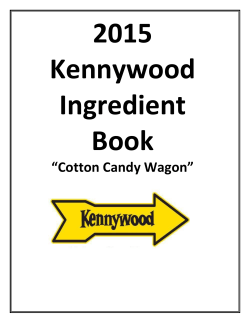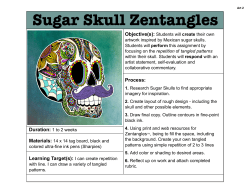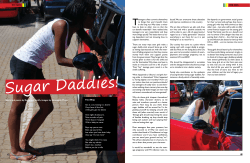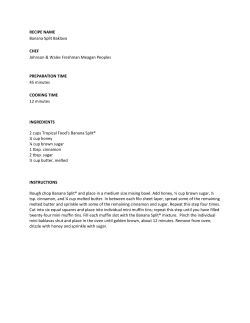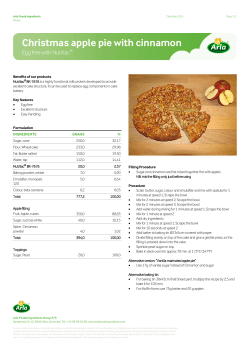
Appendix 1 - Australian Sugar Milling Council
29 April 2015 Mr Dominic Nolan Chief Executive Officer Australian Sugar Milling Council Sent By Email: asmc@asmc.com.au Dear Mr Nolan Thank you for your request to provide an independent assessment of commercial arrangements in the purchase of sugarcane and marketing of sugar in the Australian sugar supply chain. Please find attached our report “An Assessment of Australian Sugar Marketing Commercial Arrangements”. Yours sincerely Joe Dimasi Professorial Fellow, Faculty of Business and Economics, Monash University Graeme Samuel AC Vice Chancellor’s Professorial Fellow, Monash Business School, Monash University AN ASSESSMENT OF AUSTRALIAN SUGAR MARKETING COMMERCIAL ARRANGEMENTS Graeme Samuel & Joe Dimasi This report provides an assessment of the marketing arrangements in the Australian sugar industry. In particular we have looked at the arrangements between growers under the current voluntary marketing arrangements. Under these arrangements the marketing of sugar is largely conducted by Queensland Sugar Limited (QSL), the former single desk export marketing operator of Australian sugar. We have also looked at the implications of the proposed changes in 2017 where a number of millers, Wilmar, MSF Sugar and Tully Sugar, have indicated that they propose to move away from the voluntary joint marketing arrangements and will conduct their own marketing. Current Industry Arrangements The industry in Australia comprises around 4400 sugarcane farming businesses supplying 24 mills. Six companies own 20 of the mills and account for over 95% of sugar production and 100% of sugar exports.1 Prior to 2006 the industry was heavily regulated with a legislated single desk marketing arrangement conducted by QSL or its predecessors. Following deregulation a voluntary marketing system was put in place where QSL continued to market the vast majority of the crop. The centralisation of marketing is not uncommon following deregulation of primary production industries as it effectively replicates the previous regulated environment. However, centralisation ultimately breaks down in favour of more individual mechanisms designed to meet market needs. Three of the millers have indicated that they propose to exit the voluntary marketing arrangements and will undertake their own marketing. They have given notice, as is required under the current contractual arrangements, to do so from 2017. This has given rise to grower concerns. These concerns arise from the view that the mills have market power and the move away from the current arrangements will have the following outcomes: • Grower influence on the marketing of sugar will be lost or diminished; and • Returns to growers, in particular the component of returns from marketing, will be diminished as this component is not transparent to growers.2 1 Data provided by the Australian Sugar Milling Council 2 Submission to the Standing Committees on Rural and Regional affairs and Transport, Current and Future Arrangements for the marketing of Australian sugar, Submission by Canegrowers and Australian Cane Farmers. This submission also makes other points such as the ownership structure of sugar. Those issues are dealt with elsewhere. Samuel / Dimasi p1 Report for ASMC, 28 April 2015 The Relationship between Growers and Millers Around 4400 growers produce Australia’s cane crop. There is an extensive cane railway network in Queensland which is owned by the mills. The mills pay for the transportation of sugar cane from agreed delivery points to the mills. It is recognised that transportation costs and time make it uneconomic to move cane distances in excess of around 100 kilometres, hence in most instances it is not practical for growers to deliver to more than one mill. They do not have the choice to deliver to alternative mills. Growers are concerned that as a result mills have market power. This, however, is mitigated by a number of factors: • Mills need a certain supply of cane to be viable. Mills are also constrained to largely source from their local area. Our understanding is that mills have excess capacity so it is in their interest to encourage growers to continue to grow sugarcane. Once land is lost to other activities it may be difficult to get it back for sugar cane production. • Growers are statutorily authorised under the Sugar Industry Act to collectively negotiate with the mills. Several grower collectives negotiate on behalf of growers. As a result growers and mills are dependent on each other. These are important considerations in the commercial relationship between millers and growers. The payment arrangements between millers and growers which have developed over the years to deal with this interdependency are at the heart of the matter. Pricing Of Sugar As sugar is a globally traded commodity the price of sugar is set on the international market. The net price of sugar has two components. The first is the globally traded price. This is the Intercontinental Exchange Number 11 raw sugar futures contract price (ICE11). This price is set independently from the mills. The other component in the net price of sugar is the marketing premiums net of the marketing costs. The premiums are made up of physical premiums and quality premiums. The physical premiums can be due to the locational advantage in supplying some markets, such as Asian markets, which might result in lower freight and other transportation costs for Australian marketers. The quality premiums are also known as polarisation premiums. These arise where the sucrose purity is greater than the reference level set in the ICE 11 contract. Marketing costs are subtracted from the price. Samuel / Dimasi p2 Report for ASMC, 28 April 2015 Cane Payment Arrangements Cane Supply Agreements (CSAs) govern the arrangements between growers and millers. These are commercially negotiated and agreed between millers and growers, often through grower collectives. CSAs cover an extensive list of issues and set out in substantial detail the responsibilities of the miller and the growers. These include the harvesting schedule and delivery of cane to the mill; haulage and transport arrangements; quality of the cane; timing of payments; the process of changing the CSA; and a dispute resolution process including independent arbitration. The critical component of the agreement is the cane payment formula. This has been around for about 100 years and is now given effect though contractual arrangements. The formula can be expressed as follows Pc = Mill Efficiency Factor x Ps (CCS-4) + Constant. where Ps = ICE11 Price + marketing premiums – marketing costs. The cane payment which the grower receives is largely determined by the following factors: a) The mill efficiency rating. The efficiency rating is .09. This is a long standing rating and is known. b) The sucrose component (CCS-4). We understand that the rating typically ranges from 12 – 16 and measures the amount of sugar that can be extracted from a tonne of cane. According to the formula four units are allocated to the mill and the remaining units are allocated to the grower. c) The net sugar price. As is explained above this is set independently of the mill and is largely transparent. It includes the internationally globally traded price of sugar and the marketing premiums net of marketing costs. The standard raw sugar extraction for the mills (90 coefficient of work) and the standard of sugar content of cane for the grower (12 CCS) were based on 5 year averages at the time when they were set. They were set on the premise that the ratio of costs and assets between growers and millers at the time were in the ratio of 2:1. Increased efficiency in sugar extraction above the level in the formula would be fully retained by the miller while higher sugar content above 12CCS would be fully retained by the grower.3 We have set out the components of the formula in some detail as it is critical to the issues of concern. 3 J. M. Craigie Regulation and Reform of the Queensland Sugar Industry. October 2014. Samuel / Dimasi p3 Report for ASMC, 28 April 2015 The payment formula has been a long standing feature of the arrangements between growers and millers. It recognises the link between sugar cane and sugar pricing, it rewards mills for greater efficiency in extracting sugar from the cane and it rewards growers for higher quality cane. It also has the advantage in that most of its components are transparent. The marketing premiums and costs are less transparent and we will turn to this issue later in the report. As the payment of sugar cane is linked to the globally traded price of sugar, growers are exposed to fluctuations in the price of sugar. To manage this risk growers are provided access to hedging arrangement to manage their exposure to the ICE11 price. Market Power A situation where a large number of small suppliers have little option but to supply to a single processor would normally be associated with the presence of market power. However, as referred to above and set out in detail in The Hildebrand Report4 the relationship between growers and millers is largely one of interdependence. This and the fact that growers are able to, and do negotiate collectively effectively, constrains potential market power by the mills. The current payment arrangements and the transparency which they provide also play an important part. There are also provisions in the Competition and Consumer Act that can be used in the event that growers believe that mills are engaging in unfair business practices. These include provisions in the Australian Consumer law that deal with unconscionable conduct, misleading or deceptive conduct or unfair contracts. These provisions have been the subject of significant court interpretation and reform over recent years, such that they have assumed clear relevance in setting the terms of acceptable relationships between suppliers and customers - or in this case growers and processors. In particular, the recent Review of National Competition Policy (the Harper Review) noted 5 A number of submissions, particularly from agricultural producers, raise concerns that the unconscionable conduct provisions are deficient because of the lack of specific definition or the difficulty in proving that the conduct meets the standard of judicially-defined unconscionable conduct. The Panel notes that, in December 2014, the Federal Court by consent made declarations that Coles Supermarkets Australia Pty Ltd engaged in unconscionable conduct in 2011 in its dealings with certain suppliers. The Court also ordered Coles to pay combined pecuniary penalties of $10 million, and Coles agreed to enter a court enforceable undertaking with the ACCC to provide redress to more than 200 of its suppliers referred to in the proceedings. 4 Independent Assessment of the Sugar Industry 2002, Clive Hildebrand, Report to the Hon. Warren Truss MP, Minister for Agriculture, Fisheries and Forestry. 5 Competition Policy Review, Final Report, Commonwealth of Australia 2015. P356 Samuel / Dimasi p4 Report for ASMC, 28 April 2015 This successful conclusion to a case of business-to-business unconscionable conduct indicates that the current unconscionable conduct provisions appear to be working as intended. Comparison with Other Sectors The issue of imbalance of power between participants in the vertical supply chain has been addressed in other sectors. Supermarkets and their suppliers, horticulture and access to wheat port handling are examples where policy makers have become involved. But in some cases the intervention has been a political response to concerns of small growers, with the imposition of regulation, in various forms, to address perceived deficiencies in the normal market operations. In the first two of these examples the main issues that have given rise to concerns include lack of price transparency, dealing with wastage, and claims of unilaterally imposed changes without adequate consultation or negotiation. In the case of wheat port handling arrangements a code has been established which include the provision for arbitration. This, however, replaced more direct regulatory supervision by the regulator under Part 3A of the Competition and Consumer Act. This provision is there to deal with access to monopoly essential infrastructure facilities. In some circumstances some wheat handling facilities were regarded as being effectively in a monopoly position. It should be noted that the adoption of a Code of Conduct, whether expressed to be mandatory or voluntary, is effectively the imposition of regulation on business practices. As noted in the Harper Review6 The language used in the CCA is confusing, as voluntary codes may be created by legislation or ministerial order. The paradox of this is noted by Freiberg who states ‘There are thousands of voluntary codes of conduct or practice that operate independently of government. However, and possibly oxymoronically ‘voluntary codes’ may be recognised or created by legislation or ministerial order.’ Freiberg, A 2010, The Tools of Regulation, The Federation Press, Sydney, page 192. We would strongly recommend that the industry does not adopt a Code of Conduct. The industry is transitioning, albeit slowly to a deregulated environment in which the market should be left to operate its own devices with the consequent advantages of deregulation that formed the motivation for pursuing that course of action in 2006. Put at its simplest, a Code of Conduct reinstates the regulatory environment rejected as being sub-optimal to the industry in 2006. Current and Future arrangements Moreover, the circumstances in sugar marketing are quite different to the sectors referred to above. 6 Ibid p357 Samuel / Dimasi p5 Report for ASMC, 28 April 2015 The detailed Cane Supply Agreements are collectively negotiated. The payment arrangements are transparent. The payment of cane is linked to an objective, independent world price of sugar. The other components of the payment such as the proportion going to growers and millers and the mill efficiency ratings are all known and could only be changed by agreement. These conditions make the sugar industry quite distinct from the other sectors discussed above. It is not clear that a code of conduct or the introduction of compulsory arbitration would achieve anything additional. For example the matters which the Horticulture Code covers; the need for a written agreement; the terms in the agreement; the responsibilities of growers and merchants; quality issues; dispute resolution are all issues which are extensively covered in the CSAs. Such a move may introduce an additional layer of regulation with the costs associated without any clear gains. Areas of Potential Improvement However, it is apparent that growers are concerned at the potential market environment following the exit of some mills from the QSL marketing arrangement. Most often that concern flows from the uncertainty of the future market dynamics than from any evidenced based projections of market behavior by participants in the industry. The purpose of deregulation is to allow new commercial arrangements to develop. The move by the three mills away from the voluntary marketing arrangements appear consistent with this especially as the mills involve large operators who have substantial presence, experience and expertise in the international market. The nature of the industry, the ability to collectively negotiate and the measures available in the Competition and Consumer Act are all important tools in balancing the interests of the millers and the growers. Their interests are intertwined. Both their interests are served by cooperation and trust. The new arrangements may be able to give growers greater choice and enable the millers to use their expertise to market sugar. We do not see that growers will be worse off under the proposals. However growers need to have trust in changes going forward. A particular area of contention is the marketing premiums and costs. These are less visible than the other components of the payment formula. Data provided by Wilmar Sugar to the Senate Rural and Regional Affairs Committee7 shows that over a period of 5 years the ICE11 price made up 99% of the net sugar price. The difference between marketing premiums and marketing costs accounts for 1% of the price. However these seem to be of concern to growers. As the marketing has been undertaken by QSL these premiums have been accepted by growers including in 2010 when QSL incurred losses. Going forward as the mills take over the marketing function growers may need to be satisfied that there is adequate transparency over these premiums. This could include making available to growers independent audits of the marketing premiums and costs. 7 Current and future arrangements for marketing Australian Sugar, Wimar Sugar, Submission to the Senate Rural and Regional Affairs Committee and Transport References Committee, October 2014. Samuel / Dimasi p6 Report for ASMC, 28 April 2015 Joe Dimasi is Professorial Fellow, Faculty of Business and Economics, Monash University and a former Commissioner and Senior Executive of the Australian Competition and Consumer Commission. Graeme Samuel is Vice Chancellor’s Professorial Fellow, Monash Business School, Monash University and Former Chairman of the Australian Competition and Consumer Commission. Samuel / Dimasi p7 Report for ASMC, 28 April 2015
© Copyright 2025
